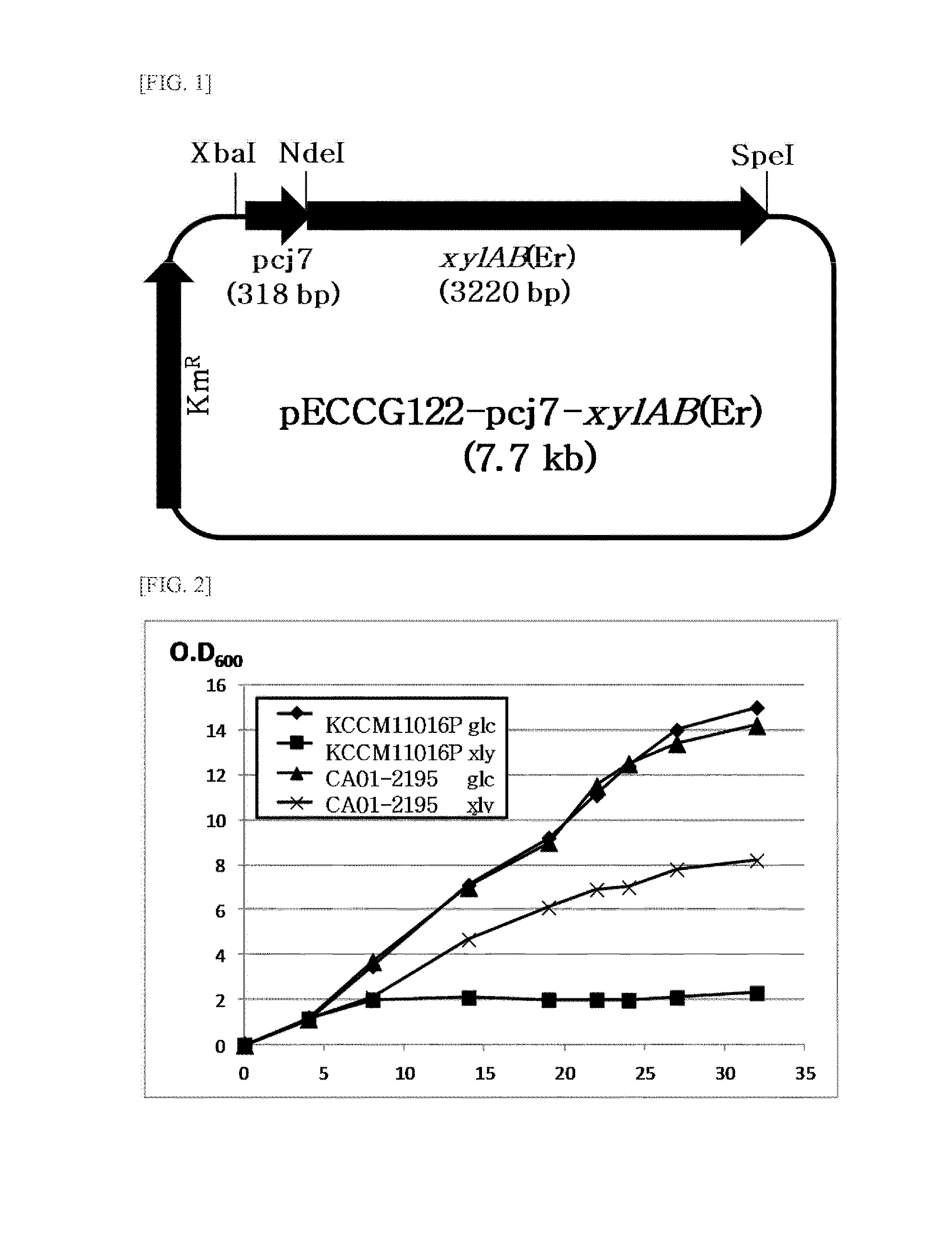Microorganisms of corynebacterium which can utilize xylose and method for producing l-lysine using same
a technology of xylose and lysine, which is applied in the direction of enzymology, bulk chemical production, transferases, etc., can solve the problem that l-amino acid cannot be produced from i>corynebacterium glutamicum
- Summary
- Abstract
- Description
- Claims
- Application Information
AI Technical Summary
Benefits of technology
Problems solved by technology
Method used
Image
Examples
example 1
Selection of Foreign Gene
[0048]Erwinia carotovora (SCRI1043)-derived ECA0097(xylA) (amino acid: SEQ ID NO: 1, nucleotide: SEQ ID NO: 3) and ECA0096(xylB) (amino acid: SEQ ID NO: 2, nucleotide: SEQ ID NO: 4) were selected as foreign genes to prepare a modified Corynebacterium sp. microorganism provided with a xylose-utilizing ability.
example 2
Construction of Erwinia carotovora-Derived xylAB Expressing Vector
[0049]Erwinia carotovora-derived XylA and XylB-encoding genes selected in Example 1 are located close to each other. Information (Accession NO. BX950851) about xylA and xylB(Er) and surrounding nucleotide sequence was obtained from US NIH GenBank, and based on the obtained nucleotide sequence, primers for amplification of Erwinia carotovora-derived xylAB(Er) were synthesized.
SEQ ID NO: 5: 5′-ACACATATGCAAGCCTATTTTGAACAGATC-3′SEQ ID NO: 6:5′-AGAACTAGTGCCTTTTGGTGGTGTTTAAGT-3′
[0050]In order to obtain the xylAB(Er) fragment, PCR was conducted using chromosomal DNA of Erwinia carotovora strain SCRI1043 as a template and a pair of primers (SEQ ID NOs: 5 and 6). PfuUltra™ high-fidelity DNA polymerase (Stratagene) was used as the polymerase, and PCR was conducted with denaturation at 94° C. for 5 minutes, followed by repeating the cycle 30 times including denaturation at 94° C. for 30 seconds, annealing at 56° C. for 30 second...
example 3
Development of L-Lysine-Producing Strain Introduced with Erwinia carotovora-Derived xylAB and Examination of Xylose-Utilizing Ability
[0052]Each expression vector pECCG122-pcj7-xylAB(Er) obtained in Example 2 was introduced into Corynebacterium glutamicum KCCM11016P (Korean Patent Nos. 10-0159812 and 10-0397322) to prepare a xylAB(Er)-expressing transformant, Corynebacterium glutamicum CA01-2195.
[0053]In order to compare the xylose-utilizing ability between KCCM11016P and CA01-2195, the strains were cultured in a seed medium containing glucose or xylose as a carbon source and their growth characteristics were compared. They were also cultured in a production medium containing glucose or xylose as a carbon source and their L-lysine production characteristics were compared.
[0054]First, in order to compare the growth characteristics, the strains were inoculated in 25 ml of seed medium [carbon source (glucose or xylose) 10 g / l, peptone 10 g / l, yeast extract 10 g / l, urea 5 g / l, KH2PO4 4 g...
PUM
| Property | Measurement | Unit |
|---|---|---|
| pH | aaaaa | aaaaa |
| temperature | aaaaa | aaaaa |
| temperature | aaaaa | aaaaa |
Abstract
Description
Claims
Application Information
 Login to View More
Login to View More - R&D
- Intellectual Property
- Life Sciences
- Materials
- Tech Scout
- Unparalleled Data Quality
- Higher Quality Content
- 60% Fewer Hallucinations
Browse by: Latest US Patents, China's latest patents, Technical Efficacy Thesaurus, Application Domain, Technology Topic, Popular Technical Reports.
© 2025 PatSnap. All rights reserved.Legal|Privacy policy|Modern Slavery Act Transparency Statement|Sitemap|About US| Contact US: help@patsnap.com


